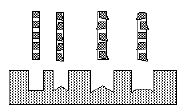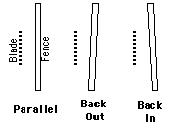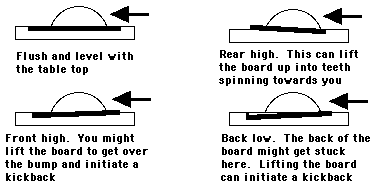Alright - what are the variables involved in this simple act of cutting a board on a table saw and how can they increase or decrease the likelyhood of a kickback?
Here's a few to consider
Stock Preparation
....flat faces and at least one straight edge against the fence
....cupped, bowed, twisted, crooked
Attempting to rip a cupped, bowed,crooked or twisted board is one of the main causes of kickbacks. If the bottom face of the board isn't flat and the edge of the board against the fence isn't straight you're definitely asking for trouble. That's because, during the cut, the wood will probably contact teeth at the back of the blade - the ones that can initiate a kickback.
The Wood
- type
. ...hard, soft or brittle
.....clear (no knots) or with knots
.....resinous or not
The saw's teeth are designed to shear off SMALL slivers of wood (small bites). Brittle wood can cause the teeth to "bite off more than it can chew". When that happens something's got to give and it's often the board and it gives by shoving the board back at you. The same things can happen when a tooth hits a knot or gets gummed up by resin. The way the tree grew can create "reaction wood" which may cause the kerf of a "reaction wood" board being ripped to close on the back of the blade or spread open, pushing away from the rip fence.
- drying method
... ..air dried
........low humidity high temeprature (Arizona?),
........high humidity high temeprature (Florida?)
........high humidity, low temperature (Minnesota?)
........low humidity,moderate temeprature (Northern California?)
.....kiln/oven dried
. ...steam dried
Drying wood too quickly can cause internal stresses to build up in the wood. These stresses can be released while cutting the board and can cause it to crook, bow, cup or twist, all of which can conttibute to a kickback
.- grain type
The Saw Blade
....straight and parallel
. ..interlocked
....wild
The saw's teeth are designed to shear off SMALL slivers of wood (small bites). Wild Grain can cause the teeth to "bite off more than it can chew". When that happens something's got to give and it's often the board and it gives by shoving the board back at you.
- internal stresses in grain
....due to stresses while tree was alive
....due to stresses developed while drying
Stresses in a board can be released while cutting. If this cause the back of the kerf to close on the back of the saw blade it can initiate a kickback. If this causes the board to bow, crook, twist or crook this may initiate a kickback
- blade width
.....regular kerf, thin kerf, dado
Dado blades remove a lot of material and the chippers between the outside blades have only two or four teeth which means they can bite off more than they can chew- When that happens a kickback can begin.
Thin kerf blades remove the least amount of material so normally are least likely to initiate a kickback. BUT, because they're thin, they can deform either due to heat build up or following hard wood wild grain. That can contribute to kickback.
- blade type
...... melamine, cross cut, combination, rip cut, dado
...... (there are more but we'll go with these)
The more teeth the less material each one bites off. Smaller bites are less likely to initiate a kickback
- teeth type
......in line square, offset alternating square
......alternating skew, alternating left skew/square/right skew

Skewed teeth shear off wood rather than chopping off wood. Cleaner cut, less force required, less likely to kick back.
- blade condition
......clean, rusty or pitch loaded
A pitch ladened blade increases the friction between the saw teeth and the wood being cut, resulting in burning the faces of the cut. That friction can also
. ....flat, cupped, twisted
. ....no missing or damaged teeth,
. ....sharp or dull teeth
A dull, deformed or damaged blade doesn't cut well but does apply forces to the board that can initiate a kickback. Of all the blade related variables, these are the most dangerous
Arbor Tilt
- Left Tilt (top of blade tilts AWAY FROM the fence)
- Right Tilt (top of blade tilts TOWARDS the fence)

As you can see from the illustration above,. the Right Tilt blade traps the stock being cut between the blade and the fence. If a kickback begins to occur ALL the force will be directed AT YOU.
Saw Motor
An underpowered saw can bog down or even stop during a cut. A motor overheating creates a distinct smell. This naturally can cause you to pull the board away from the blade. That's when you can lose control of the board. Losing control of the board can initiate a kickback.
On the other hand, a 3 HP motor is harder to bog down or stop. Buy, it can, if a kickback starts, apply a lot more force to the stock and fire it back at you with more force or throw it much higher in the air.
When it comes to motor size, bigger is better.
The Fence
- The Fence relationship to the Saw Blade
........relationship along the long axis of the blade
............parallel the whole way
............fence closer to the blade at the front of the blade
............fence closer to the blade at the back of the blade

If the back of the fence is closer to the blade than at the front of the blade it can push the stock into the teeth at the back of the blade. That can initiate a kickback
....... relationship vertically
........... face of fence and side of blade parallel
............top of blade farther from the fence than at the bottom
............top of blade closer to the fence than at the bottom

The top of the fence tilting towards the blade creates the same condition as a Right Tilt saw arbor, trapping the board being cut completeley between the blade and the fence. The result can be the board flying back at you if a kickback starts.
The Throat Plate
- relationship to the table top
....coplaner
....front high
....rear high

- Throat opening siz
........zero clearanc
........too wide
If, at the end of the cut, a piece of cut off falls into the opening in the throat plate a couple of things can happen. If it's a short piece it can catch teeth at the back of the blade spinning upward and lift the throat plate. In the worse case the throat plate can be lifted up into the teeth spinning towards the front of the table - NOT GOOD.
But the Sneaky One is more likely. The piece hitting the blade makes a hell of a racket and that can break your concentration - at a really bad time. Your hand or hands are as close to the exposed blade then at any time during the cut. You can imagaine the rest.
Feed Rate
Feeding the stock to the blade faster than the teeth can remove wood is asking for a kickback, either becaue the motor will bog down or stop and you back the board up and lose control OR, with larger motors, shove/ push/ hurl the stock back at you. (contributed by Swingman)
